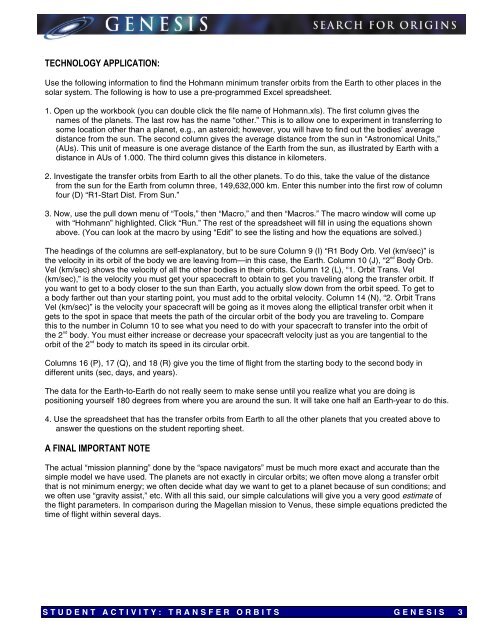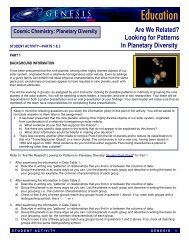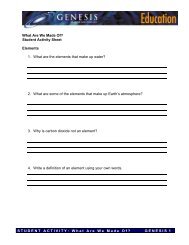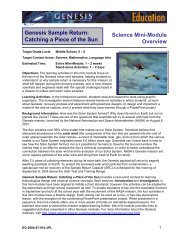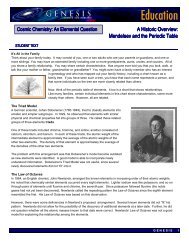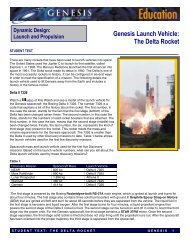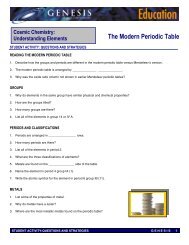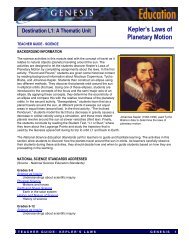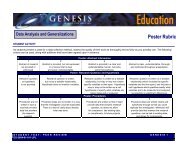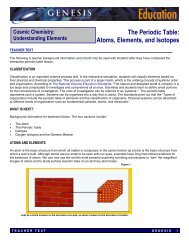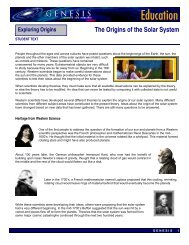A Thematic Unit Minimum Energy Transfer Orbits - Genesis
A Thematic Unit Minimum Energy Transfer Orbits - Genesis
A Thematic Unit Minimum Energy Transfer Orbits - Genesis
Create successful ePaper yourself
Turn your PDF publications into a flip-book with our unique Google optimized e-Paper software.
TECHNOLOGY APPLICATION:<br />
Use the following information to find the Hohmann minimum transfer orbits from the Earth to other places in the<br />
solar system. The following is how to use a pre-programmed Excel spreadsheet.<br />
1. Open up the workbook (you can double click the file name of Hohmann.xls). The first column gives the<br />
names of the planets. The last row has the name “other.” This is to allow one to experiment in transferring to<br />
some location other than a planet, e.g., an asteroid; however, you will have to find out the bodies’ average<br />
distance from the sun. The second column gives the average distance from the sun in “Astronomical <strong>Unit</strong>s,”<br />
(AUs). This unit of measure is one average distance of the Earth from the sun, as illustrated by Earth with a<br />
distance in AUs of 1.000. The third column gives this distance in kilometers.<br />
2. Investigate the transfer orbits from Earth to all the other planets. To do this, take the value of the distance<br />
from the sun for the Earth from column three, 149,632,000 km. Enter this number into the first row of column<br />
four (D) “R1-Start Dist. From Sun.”<br />
3. Now, use the pull down menu of “Tools,” then “Macro,” and then “Macros.” The macro window will come up<br />
with “Hohmann” highlighted. Click “Run.” The rest of the spreadsheet will fill in using the equations shown<br />
above. (You can look at the macro by using “Edit” to see the listing and how the equations are solved.)<br />
The headings of the columns are self-explanatory, but to be sure Column 9 (I) “R1 Body Orb. Vel (km/sec)” is<br />
the velocity in its orbit of the body we are leaving from—in this case, the Earth. Column 10 (J), “2 nd Body Orb.<br />
Vel (km/sec) shows the velocity of all the other bodies in their orbits. Column 12 (L), “1. Orbit Trans. Vel<br />
(km/sec),” is the velocity you must get your spacecraft to obtain to get you traveling along the transfer orbit. If<br />
you want to get to a body closer to the sun than Earth, you actually slow down from the orbit speed. To get to<br />
a body farther out than your starting point, you must add to the orbital velocity. Column 14 (N), “2. Orbit Trans<br />
Vel (km/sec)” is the velocity your spacecraft will be going as it moves along the elliptical transfer orbit when it<br />
gets to the spot in space that meets the path of the circular orbit of the body you are traveling to. Compare<br />
this to the number in Column 10 to see what you need to do with your spacecraft to transfer into the orbit of<br />
the 2 nd body. You must either increase or decrease your spacecraft velocity just as you are tangential to the<br />
orbit of the 2 nd body to match its speed in its circular orbit.<br />
Columns 16 (P), 17 (Q), and 18 (R) give you the time of flight from the starting body to the second body in<br />
different units (sec, days, and years).<br />
The data for the Earth-to-Earth do not really seem to make sense until you realize what you are doing is<br />
positioning yourself 180 degrees from where you are around the sun. It will take one half an Earth-year to do this.<br />
4. Use the spreadsheet that has the transfer orbits from Earth to all the other planets that you created above to<br />
answer the questions on the student reporting sheet.<br />
A FINAL IMPORTANT NOTE<br />
The actual “mission planning” done by the “space navigators” must be much more exact and accurate than the<br />
simple model we have used. The planets are not exactly in circular orbits; we often move along a transfer orbit<br />
that is not minimum energy; we often decide what day we want to get to a planet because of sun conditions; and<br />
we often use “gravity assist,” etc. With all this said, our simple calculations will give you a very good estimate of<br />
the flight parameters. In comparison during the Magellan mission to Venus, these simple equations predicted the<br />
time of flight within several days.<br />
STUDENT ACTIVITY: TRANSFER ORBITS GENESIS<br />
3


